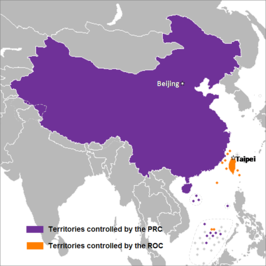Two Chinas
| Two Chinas | |||||||||||||

Territory controlled by the People's Republic of China (PRC) (purple) and the Republic of China (ROC) (orange). The size of minor islands has been exaggerated in this map for ease of identification.
|
|||||||||||||
| Traditional Chinese | 兩個中國 | ||||||||||||
|---|---|---|---|---|---|---|---|---|---|---|---|---|---|
| Simplified Chinese | 两个中国 | ||||||||||||
|
|||||||||||||
| Transcriptions | |
|---|---|
| Standard Mandarin | |
| Hanyu Pinyin | liǎng gè Zhōngguó liǎng ge Zhōngguó |
| Bopomofo | ㄌㄧㄤˇ ㄍㄜ` ㄓㄨㄥ ㄍㄨㄛ´ |
| Wade–Giles | liang3 ge4 zhong1 guo2 |
| Yale Romanization | LyangGeJungGwo |
The term Two Chinas refers to the current situation where two political entities each name themselves "China":
In 1912, the Xuantong Emperor abdicated as a result of the Xinhai Revolution, and the Republic of China was established in Nanjing by revolutionaries under Sun Yat-sen. At the same time, the Beiyang Government, led by Yuan Shikai, a former Qing Dynasty General, existed in Beijing, whose legitimacy was challenged by the Nanjing government under the Kuomintang, or the Chinese Nationalist Party.
From 1912 to 1949, China was scarred by Warlords, the Japanese invasion and the Chinese Civil War. Throughout this turbulent period, various short-lived governments have existed in China. These include Yuan Shikai's Beiyang Government (1912–1928), the Chinese Soviet Republic established by the Communist Party of China (1931–1937), the Fujian People's Government (1933–1934), the puppet state of Manchukuo (1932–1945), and Wang Jingwei's Japanese sponsored puppet state (1940–1945).
As the Chinese Civil War ended in 1949, the Chinese communist People's Republic of China (PRC), led by Chairman Mao Zedong, took control of Mainland China. The Republic of China, led by President Chiang Kai-Shek, retreated the government of the Republic of China to Taiwan.
...
Wikipedia
